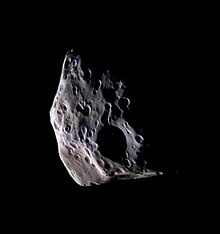土卫十一
外观
(重定向自S/1980 S 3)
 卡西尼號在2007年12月3日拍攝的影像。 | |
| 发现 | |
|---|---|
| 發現者 | 理查沃克(Richard Walker) |
| 發現日期 | 1966年12月18日 |
| 編號 | |
| 形容詞 | Epimethean |
| 軌道參數 [1] | |
| 曆元 2003年12月31日 (JD 2453005.5) | |
| 半長軸 | 151410±10 km |
| 離心率 | 0.0098 |
| 軌道週期 | 0.694333517 d |
| 軌道傾角 | 0.351°±0.004° (對土星的赤道) |
| 隸屬天体 | 土星 |
| 物理特徵 | |
| 大小 | 129.8 × 114 × 106.2 km [2] |
| 平均半徑 | 58.1±1.8 km [2] |
| 體積 | ≈ 780000 km3 |
| 質量 | (5.266±0.006)×1017 kg [2] |
| 平均密度 | 0.640±0.062 g/cm³ [2] |
| 表面重力 | 0.0064–0.011 m/s² [2] |
| ≈ 0.035 km/s | |
| 自轉週期 | 同步的 |
| 轉軸傾角 | 0 |
| 反照率 | 0.73±0.03 (幾何的) [3] |
| 溫度 | ≈ 78 K |

土星 · 土卫十 · 土卫十一
土衛十一又稱為「艾比米修斯」(Epimetheus),是土星的一顆內側衛星,它的專屬名稱艾比米修斯源自神話,是普羅米修斯的兄弟。
發現
[编辑]
本質上,土衛十一和土衛十(Janus)佔有相同的軌道,但是天文學家認為只有一個天體在這個軌道,相對應的是難以確定這個軌道的特性。每次的攝影觀測都間隔了很長的時間,但是因為有兩個天體並存,因此很難整理與調和出合理的軌道[來源請求]。
Audouin Dollfus在1966年12月15日觀察到一顆衛星,[4]他建議命名為Janus。[5]在12月18日,理查·沃克也做了相似的觀測,現在知道他發現了土衛十一。[5][6] 然而,在當時,它被認為應該只有一顆衛星,非正式的認為只有土衛十在給定的軌道上[來源請求]。
12年後,在1978年10月,Stephen M. Larson和John W. Fountain意識到有兩個不同的天體(土衛十和土衛十一)共用了非常相似的軌道,為1966年的觀測做了最好的解釋。[7]在1980年,航海家1號證實了這一點,[8]所以拉爾森(Larson)和方騰(Fountain)與沃克分享了土衛十一的發現[來源請求]。
土衛十一在1983年正式命名為厄庇墨透斯(Epimetheus),[a] 這個名字與土衛十同時由國際天文學聯合會批准,雖然Dollfusy在1966年發現土衛十之後不久就已經提出,並且非正式的使用[來源請求]。
相關條目
[编辑]參考資料
[编辑]註解
- ^ Transactions of the International Astronomical Union, Vol. XVIIIA, 1982 (confirms Janus, names Epimetheus, Telesto, Calypso) (mentioned in IAUC 3872: Satellites of Jupiter and Saturn 1983 September 30)
文獻
來源
- J.W. Fountain, S.M. Larson. Saturn's ring and nearby faint satellites. Icarus: 92–106. [2018-04-02]. doi:10.1016/0019-1035(78)90076-3. (原始内容存档于2020-08-05).
- Gingerich, Owen. Probable New Satellite of Saturn (discovery). IAU Circular. January 3, 1967, 1987 [2011-12-28]. (原始内容存档于2011-07-25).
- Gingerich, Owen. Possible New Satellite of Saturn. IAU Circular. January 6, 1967, 1991 [2011-12-28]. (原始内容存档于2017-09-29).
- Gingerich, Owen. Saturn X (Janus) (naming Janus). IAU Circular. February 1, 1967, 1995 [2011-12-28]. (原始内容存档于2011-07-25).
- PIA08328: Moon-Made Rings. Photojournal. JPL/NASA. 2006-10-11 [2011-12-29]. (原始内容存档于2009-01-22).
- PIA09813: Epimetheus Revealed. Photojournal. JPL/NASA. 2008-01-11 [2011-12-29]. (原始内容存档于2020-08-02).
- The Dancing Moons. Cassini Solstice Mission. JPL/NASA. May 3, 2006 [2011-12-29]. (原始内容存档于2011-06-10).
- NASA Finds Saturn's Moons May Be Creating New Rings. Cassini Solstice Mission. JPL/NASA. October 11, 2006 [2011-12-29]. (原始内容存档于2012-02-12).
- Leverington, David. Babylon to Voyager and beyond: a history of planetary astronomy. Cambridge University Press. 2003. ISBN 0-521-80840-5.
- Marsden, Brian G. Satellites of Jupiter and Saturn. IAU Circular. September 30, 1983, 3872 [2011-12-23]. (原始内容存档于2011-07-25).
- J. N. Spitale, R. A. Jacobson, C. C. Porco, Jr. W. M. Owen. The Orbits of Saturn's Small Satellites Derived from Combined Historic and Cassini Imaging Observations. The Astronomical Journal. 2006, 132 (2): 692 [2018-04-02]. ISSN 1538-3881. doi:10.1086/505206 (英语).
- P.C. Thomas. Sizes, shapes, and derived properties of the saturnian satellites after the Cassini nominal mission. Icarus: 395–401. [2018-04-02]. doi:10.1016/j.icarus.2010.01.025. (原始内容存档于2020-08-02).
- Anne Verbiscer, Richard French, Mark Showalter, Paul Helfenstein. Enceladus: Cosmic Graffiti Artist Caught in the Act. Science. 2007-02-09, 315 (5813): 815–815 [2018-04-02]. ISSN 0036-8075. doi:10.1126/science.1134681. (原始内容存档于2020-12-31) (英语).
外部連結
[编辑]- Epimetheus Profileby NASA's Solar System Exploration(页面存档备份,存于互联网档案馆)
- The Planetary Society: Epimetheus
- Cassini Images of Epimetheus (页面存档备份,存于互联网档案馆)
- 'Solar System Dynamics' by Murray and Dermott(页面存档备份,存于互联网档案馆) The standard text on the subject, describes the orbits in detail.
- QuickTime animation of co-orbital motion(页面存档备份,存于互联网档案馆) from Murray and Dermott
- Cassini image of Janus and Epimetheus near the time of their orbital swap.
- Epimetheus nomenclature (页面存档备份,存于互联网档案馆) from the USGS planetary nomenclature page(页面存档备份,存于互联网档案馆)
